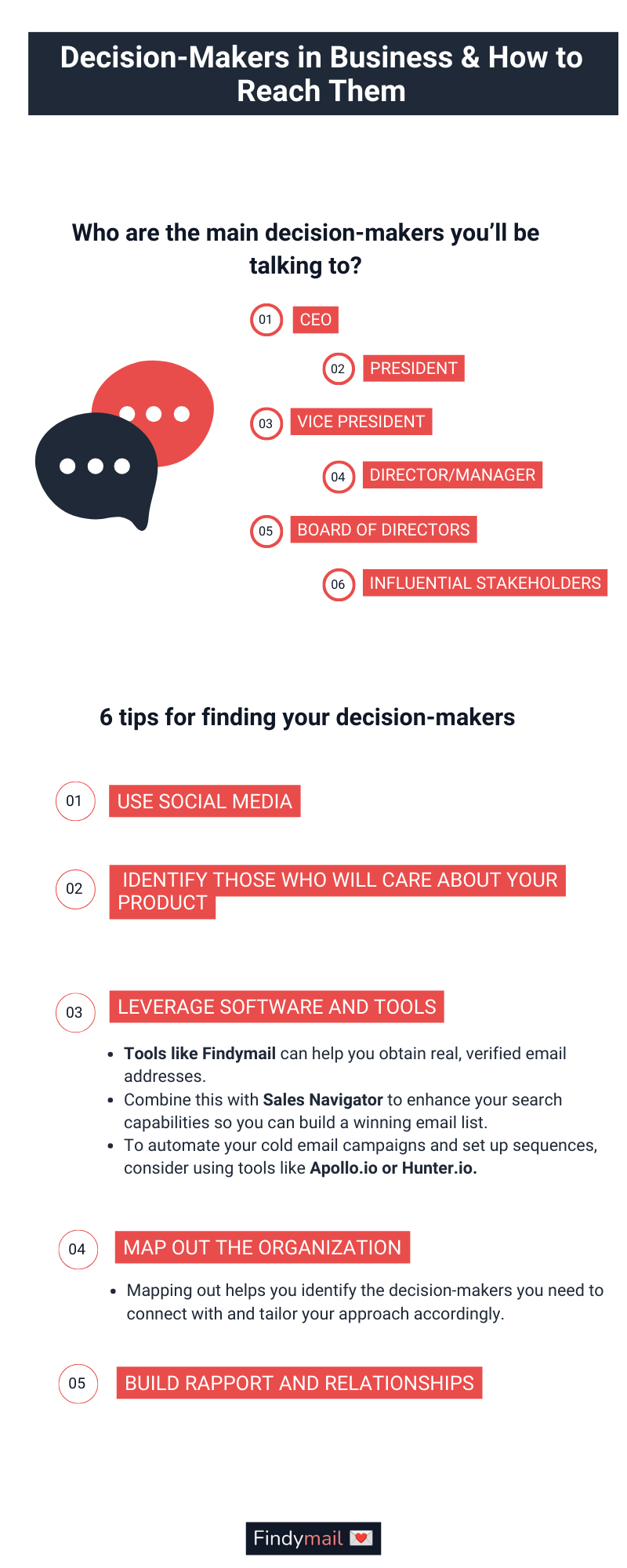Have you ever felt like you're spinning your wheels in B2B sales?
You can have a rockstar sales team, but if they can't connect with the right people, all their efforts can go down the drain.
Trust me; I've been there. That's why I'm here to share everything you need to know about those all-important decision-makers and how to approach and close them successfully.
In this article, we'll dive deep into the world of decision-makers in business. We'll explore who they are and why they hold the key to making your sales proposals a reality.
It's not as daunting as it seems, and with the right tactics, you'll be sealing deals like a pro in no time.
Decision Makers vs. Gatekeepers
Alright, let's first clear up the difference between decision-makers and gatekeepers and figure out who's who.
So, decision-makers. These are the big shots with the power to make dreams come true (or crush them). They're the ones who give the final nod to your proposals.
They're high-level executives or managers who call the shots, dish out the budgets, and set the company's course. Basically, they're holding the keys to the kingdom, and your goal is to win them over.
Then gatekeepers – well, picture them as the gatekeepers (duh!) to the decision-makers. They're like the bouncers at the coolest club in town.
Gatekeepers can be executive assistants, department heads, or influential folks who control access. They don't have the final say, but you might need to impress them to even get a chance.
Throughout your quest toward the decision-maker, you’ll need to make gatekeepers your allies.
Who are the Decision Makers?
When it comes to decision-makers in business, there's a cast of characters that you should get familiar with. Let's meet the key players who hold the power to sign off on your proposals and make things happen:
- CEO: The big cheese, the top dog. The CEO is the head honcho of the company, responsible for the overall strategic direction and decision-making. Their approval can make or break your proposal.
- President: Depending on the organization, the President may have different roles and responsibilities. They could be the second-in-command after the CEO, overseeing operations or specific departments. Their buy-in is vital for major decisions.
- Vice President: VPs come in a variety of flavors, such as VP of Sales, Marketing, Finance, or Operations. They play a crucial role in their respective areas and often have decision-making authority within their domains. Building rapport with VPs can open doors to getting your proposal in front of the right people.
- Director/Manager: These are the folks who oversee specific departments or teams within the organization. They may have decision-making authority for projects or initiatives within their scope. Collaborating with them can pave the way to reaching higher-level decision-makers.
- Board of Directors: The esteemed group of individuals responsible for governance and overseeing the organization's strategic direction. They are usually high-profile individuals with vast experience and influence. Gaining their support can be a game-changer for your proposal.
- Influential Stakeholders: Depending on the nature of your proposal, other stakeholders within the company may hold decision-making authority. It could be department heads, project managers, or key team leaders who have a say in the initiatives they oversee.

Remember, decision-makers come in all shapes and sizes within an organization. Understanding who they are and their respective roles is crucial in tailoring your approach and building relationships with them.
Approaching the CEO
If you want to win over the big dog, understanding their background is critical. Research their preferences and tailor your pitch accordingly.
When pitching a CEO, you need to exude confidence and avoid using complex jargon. Keep your pitch concise and be prepared to address any questions they may have.
Remember, their time is precious, so respect their schedule and get to the point quickly. Anticipate their sharp mind and be ready with well-thought-out responses.
Lastly, connect on a personal level to establish rapport. Show authenticity and let your passion shine through.
Approaching the President
Approaching the president requires finesse, conviction, and a deep understanding of their goals.
Show them that you believe in the value of your product or service and how it aligns with their goals. Confidence is contagious and can inspire trust in your proposition.
Highlight the ways your offering can directly contribute to their objectives. Help them envision the positive impact it will have on their business.
Clearly articulate how your product/service can help them overcome challenges, seize opportunities, or achieve greater efficiency.
Approaching the Vice President, Manager, or Stakeholder
When pitching the vice president, manager, or stakeholder, you can follow a similar approach to pitching the president, but with a strategic twist – incorporate their specific goals into your pitch to demonstrate how your product/service will help them get there.
Be prepared to answer any questions they may have and keep your pitch focused and to the point.
Of course, you’ll need to get to this point, so let’s look at some tips and tricks for finding decision-makers and what to do when you’ve figured it out.
6 Tips for Finding Decision Makers
Here are 6 tips I’ve used over the years that have helped me hone in on key players and get them down my sales pipeline.
1) Use Social Media
Social media platforms like LinkedIn and Twitter can be gold mines for finding decision-makers and establishing contact with them. You can send direct messages but don't limit yourself to just that.
Take advantage of these platforms to gather information and find email addresses. Cold emails are a powerful tactic; they can effectively grab the decision-maker's attention.
2) Identify Those Who Will Care About Your Product
While talking to the CEO might seem like the ultimate goal, sometimes you need to zoom in on the person within the company who will benefit the most from your product or solution.
Do your research and find the individual who will experience the greatest impact.
Engage them in a meaningful conversation by bringing up something relevant you discovered about their company, whether it's from the news, their corporate website, or even their Twitter account.
Focus on discussing the problem you are solving rather than immediately diving into your product.
For example, if you’re selling email security software, you could say something like, "Hey, curious to get your thoughts on the state of email security? What problems are you seeing out there with your clients?"
3) Leverage Software and Tools
Make use of software and tools that can streamline your outreach efforts.
Tools like Findymail can help you obtain real, verified email addresses. Combine this with Sales Navigator to enhance your search capabilities so you can build a winning email list.
To automate your cold email campaigns and set up sequences, consider using tools like Apollo.io or Hunter.io.
Additionally, explore data enrichment tools that can fill in missing information about decision makers, such as their roles and contact details.
4) Map Out the Organization
When targeting a company, it's important to understand its organizational structure. Tools like Sales Navigator or LinkedIn advanced search can provide valuable insights into who holds key positions within the company.
By mapping out the organization, you can identify the decision-makers you need to connect with and tailor your approach accordingly.
5) Build Rapport and Relationships
Establishing a rapport with decision-makers is essential. It's your job to find creative and relevant ways to stay on their radar.
Follow their content on social media, share insightful articles or industry news, and find opportunities to add value to their professional lives.
Remember, building relationships takes time and effort. Be persistent but not pushy, and demonstrate that you genuinely care about their success.
6) Focus on Them, Not You or Your Product/Service
Decision makers receive a constant stream of cold emails and sales pitches. They've seen it all – the flashy tricks and persuasive tactics. To stand out from the crowd, you need to be real, genuine, and, most importantly, focused on them.
Shift your approach from a self-centered pitch to a customer-centric mindset. Take the time to understand their pain points, challenges, and goals.
Show genuine interest in their success and the problems they face. This means doing your research, digging deep into their industry, and demonstrating that you have valuable insights to offer.
Make Your Own Opportunities with Findymail
When you find (and approach) decision-makers, you’re paving the way to creating your own opportunities and success.
Throughout this article, I've explored the ins and outs of connecting with these key individuals and provided valuable tips to help you navigate this challenging but rewarding task.
And if you need a little help along the way, remember that Findymail has always got your back. Get legit email addresses for key decision-makers and more when building out your email list!
And if you want more fire info on how to take your next sales game to the next level, you know where to come. 😉
Until next time!






